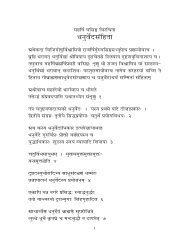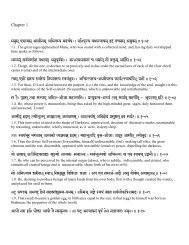Shri Bhairava Deva - Hindu Online
Shri Bhairava Deva - Hindu Online
Shri Bhairava Deva - Hindu Online
You also want an ePaper? Increase the reach of your titles
YUMPU automatically turns print PDFs into web optimized ePapers that Google loves.
<strong>Shri</strong> <strong>Bhairava</strong> <strong>Deva</strong><br />
<strong>Bhairava</strong> holds within Himself the entire universe by reducing all the shaktis to sameness with Himself and<br />
inasmuch as He completely devours within Himself the entire mass of ideation (which is responsible for<br />
sense of difference) - Shiva Sutras, Jaideva Singh<br />
<strong>Bhairava</strong> means "terrifying" and it is an adjective applied to Shiva in his fearful aspect. Yet in Kashmir<br />
Shaivism, the three letters of this name are taken in a different manner. Bha means bharana, maintenance;<br />
ra means ravana, withdrawal and va means vamana, creation of the universe.<br />
The Rudrayamala Tantra, quoted in a puja manual <strong>Bhairava</strong> Upasana, describes the worship of Vatuka<br />
<strong>Bhairava</strong>, or <strong>Bhairava</strong> as a small boy, and gives his mantra as hrim vatukaya apadudharanaya kuru kuru<br />
batukaya hrim. Although the ascription to Rudrayamala is commonly found in the colophons of tantrik<br />
texts, these passages do not appear in the modern work now available.<br />
However, the same work gives dhyanas, or meditation images of Vatuka <strong>Bhairava</strong> as comprising the entire<br />
three gunas, and also separately as Vatuka in his sattvik, rajasik and tamasik guises. In his form as the three<br />
gunas, he is described as being like pure crystal, effulgent as the rays from 1,000 suns, shining like a<br />
sapphire thundercloud and wearing sapphire coloured clothing. He has three eyes, eight arms, four arms<br />
and two arms, depending on the preponderance of the guna, has a fanged, fearsome gaping mouth, and a<br />
girdle and anklets of live serpents. He is digambara (naked as space), He is the prince-lord (Kumaresha),<br />
and is very powerful. In his right hands he holds a staff with a skull on the top (khatvanga), a sword, a<br />
noose and a trident. His left hands hold the hourglass-shaped damaru drum, a skull, he shows the mudra<br />
bestowing boons and holds a snake in the last.<br />
The sattvik dhyana describes Vatuka <strong>Bhairava</strong> as resembling crystal, and as white as the kunda flower,<br />
wearing celestial clothing and nine gems, of a flaming appearance, adorned with anklets of bells, having a<br />
bright, beautiful and handsome face, with three eyes. He has two hands, one of which wields a trident<br />
(shula).
The rajasik dhyana says he resembles the rising sun, with three eyes, with red limbs, in his four hands<br />
showing the sign bestowing boons, and holding a skull. In one of his left hands he holds a trident and with<br />
the other shows the mudra (hand gesture) dispelling fear. He has a blue, bejewelled throat, on his forehead<br />
is a fragment (kala) of the crescent moon and he wears clothes red as the banduka flower.<br />
The last, tamasik dhyana, has Vatuka <strong>Bhairava</strong> as stark naked, blue in colour, with reddened hair, with<br />
terrifying fangs, three eyes, anklets of jingling bells, and with eight arms.<br />
The yantra of <strong>Bhairava</strong>, in all his different forms, is similar to that shown below.<br />
From the yogic point of view, if an individual applies the <strong>Bhairava</strong> Mudra, he or she looks both outwards<br />
and inwards at the same time and is one with Shiva-Shakti. <strong>Bhairava</strong> is terrible, terrifying, because he<br />
represents pure consciousness, before which the kleshas (obstacles) and conditioning of an ignorant human<br />
being crumble. The following chapter from the Netra Tantra reveals more of the mysteries of <strong>Bhairava</strong>.<br />
<strong>Shri</strong> Netra Tantra 10<br />
Bhagavan said: Now I speak of the characteristics of the <strong>Bhairava</strong> Agama, resembling a mass of fragments<br />
of collyrium, like the fire at the end of an aeon. [1]<br />
Five faced, seated on a corpse, with ten arms, the dispeller of anxiety, resembling a host of night flowers,<br />
the final peal of thunder, making a terrifying roar. [2]<br />
Having a gaping fanged mouth, and fearsome brows and eyes, enthroned on a lion-seat, adorned with<br />
vicious fangs, wearing a rosary of skulls, large in body, wearing a garment of elephant-hide, with the Moon<br />
as a diadem, carrying skull-bowl and a skull-staff, bearing a cleaver and a goad, with hands granting boons<br />
and dispelling fears. [3-5]<br />
A great hero, holding a vajra and a battle-axe. After worshipping <strong>Bhairava</strong>, one should meditate on she who<br />
is on his lap. [6]<br />
Similar to the fire causing dissolution, effulgent, like red lac and vermilion, with dishevelled hair and a<br />
mighty body, dreadful and truly terrific. [7]
With a great belly and with five faces, each of which is adorned with three eyes, having horrible talons, the<br />
protectress of the fortress, adorned with a rosary of skulls. [8]<br />
A Devi with arms like <strong>Bhairava</strong> who carries <strong>Bhairava</strong>'s weapons, thus is declared Iccha Shakti, who of her<br />
own free will goes lovingly on <strong>Bhairava</strong>'s lap. [9]<br />
Thus should one meditate on the renowned Aghoreshi having the above form. Spoken of in all tantras, but<br />
never made plain [10], my essence is by no means clear and is hard to attain. In ailments, punishment, evils<br />
and so on, in various setbacks, in protection, for desires, in pacifying and in nourishing, for cowns and for<br />
brahmins one should worship (<strong>Bhairava</strong> Yamala). Resembling a himakunda flower, like the pearly<br />
effulgence of the Moon [12], resembling 10,000,000 Moons, like the clearest crystal.<br />
(Chit <strong>Bhairava</strong>) is like the fire at the end of the aeon, red as the China rose, equivalent to 10,000,000 Suns.<br />
One should meditate on him as red or blackish in hue. Effulgent as a red lotus or like yellow orpiment [14],<br />
being of the nature of Will (Iccha), the deva bestowing the fruit of Icchasiddha.<br />
One should meditate on (these forms) placed in the centre of a lotus and should worship, according to the<br />
ritual injunction [16] with food, flower, incense and distilled liquor abundantly. The Devi resembling cow's<br />
milk, effulgent as a necklace of pearls [17] like beautiful pure crystal, white as snow, pure as camphor, with<br />
four arms and one face adorned with three eyes. [18] The Devi wearing white garments, ornamented with<br />
white pearls, seated on a deer with a vajra in her hand, very powerful, the (Siddha Devi). [19]<br />
The Devi carrying a noose and a goad, ringing a bell, is placed in the east of the god of gods. [20] A man<br />
who meditates on her as one with himself is successful quickly. (Rakta Devi) resembles 10,000,000 Suns,<br />
is as effulgent as flaming fire, like a heap of vermilion, the form of lightning, inspiring fear, with three eyes<br />
and a terrifying face, with a large belly and a great body, pot-bellied, with pendulous breasts. [22]<br />
Seated on a corpse, very powerful, wearing a rosary of skulls with a tiger skin around her hips, wearing the<br />
hide of an elephant. Naked, adorned with a garland of skulls, like great firebrands they shine and they glow.<br />
[24]<br />
With four arms and one face, holding a cleaver, a shield a skull and a skull-staff, placed in the south. One<br />
should meditate thus. [26]<br />
Dark red, the great light, skeletal with a deformed face, is Shushka, the protectress of the fortress. With one<br />
face and four arms, three eyes and a terrifying mouth, adorned with a necklace of teeth, a mighty-bodied<br />
one with dishevelled hair, adorned with a garland of skulls. [27]<br />
With limbs the tendons of which are like knotted cords, carrying a cleaver and a shield, her mouth full of<br />
meat and entrails, holding a pot in her hand. One should meditate in this way in the west of the god of gods,<br />
seated on a crocodile, with the throat of a buffalo, the shoulders of an elephant, horse's ears and the face of<br />
a ram, with diamond-hard talons like weapons, legs like a beast of prey and a crocodile, with the back of a<br />
tortoise and the tail of a fish - this is the renowned Kumbha. [31]<br />
Dusky like a blue lotus, resembling the autumnal moon and with three eyes and one face, dressed in dark<br />
clothes the colour of sapphire, adorned with sapphires, seated on the back of a lion, holding a bow and an<br />
arrow in preparedness, and carrying a dart in her hand, a great Devi. Meditated thus, she (Utpalahasta) is<br />
the giver of the desired fruit. [33]<br />
So in the four directions are situated the Devis of <strong>Bhairava</strong>, O Mother of Hosts! [34] In the intermediate<br />
points are placed the Dutis, the south east being first and the north east last. Kali, Karali, Mahakali and<br />
Bhadrakali are the renowed Devis placed there. The Devis have two arms and sit on a lotus, carrying a<br />
knife and a severed head. The attendants of the door are Krodhana, Vrintaka, Karshana and Gajanana [37],
with two arms, of deformed appearance and holding a cleaver and a shield. In the matter of pacifying acts,<br />
they are all-white, or in other acts according to their forms. [38]<br />
Now I declare the characteristics of the Rajaraksha. By the yoga of enveloping in a mantra, one should<br />
write the name in the centre. [39]<br />
Above this, one should worship the lord of nectar, who is <strong>Bhairava</strong>, dear one. Similarly, the Devis should<br />
be worshipped in the petals of the lotus. [40]<br />
Afterwards, one should worship the Dutis and the servants using the root mantra. On the outside of the<br />
lotus one should draw a very white Moon mandala. On the outside of this is a bhupura, marked with the<br />
vajra symbol. Having drawn it using rochana, kumkum or white milk, one should worship, in pacifying<br />
acts, using all-white ritual accessories, giving suitable food, and animal sacrifice of vicious beasts of prey.<br />
[43]<br />
The wise man should do homa using white sandal, mixed with camphor and ash, unhusked rice, sesame oil<br />
together with white sugar, ghee and milk. Great peace comes swiftly by worshipping the Mrityunjaya. [45]


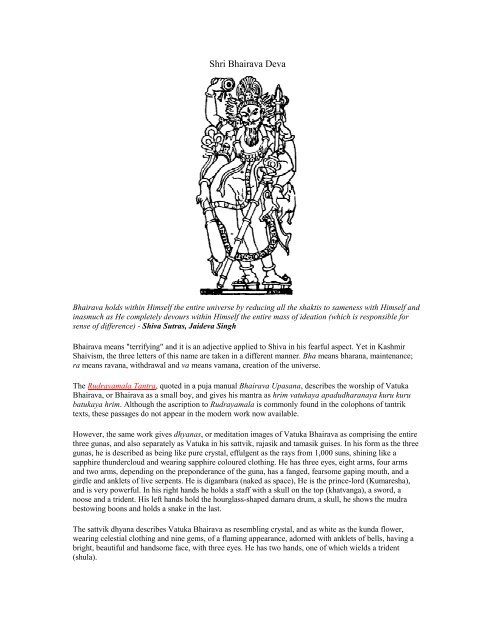
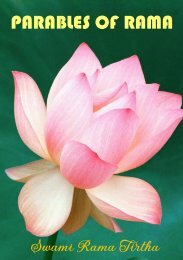
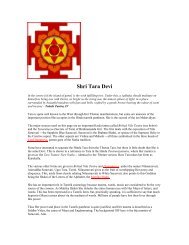
![[ Home ] [ Up ] Books Contact us Immortal Promise ... - Hindu Online](https://img.yumpu.com/9577792/1/190x245/-home-up-books-contact-us-immortal-promise-hindu-online.jpg?quality=85)
